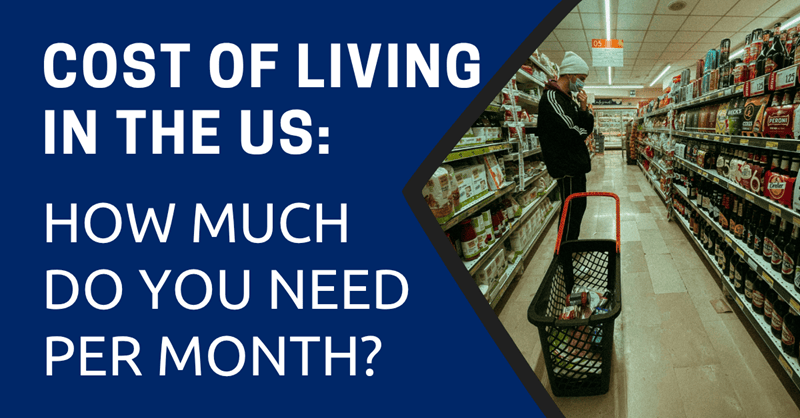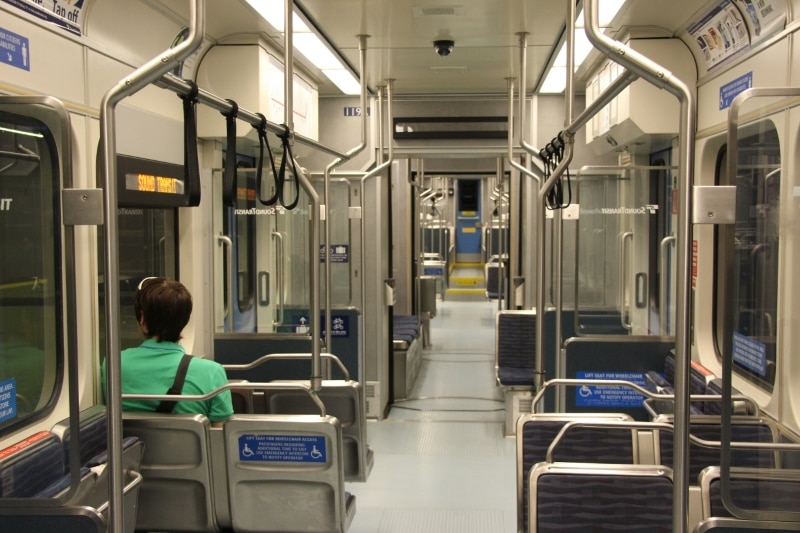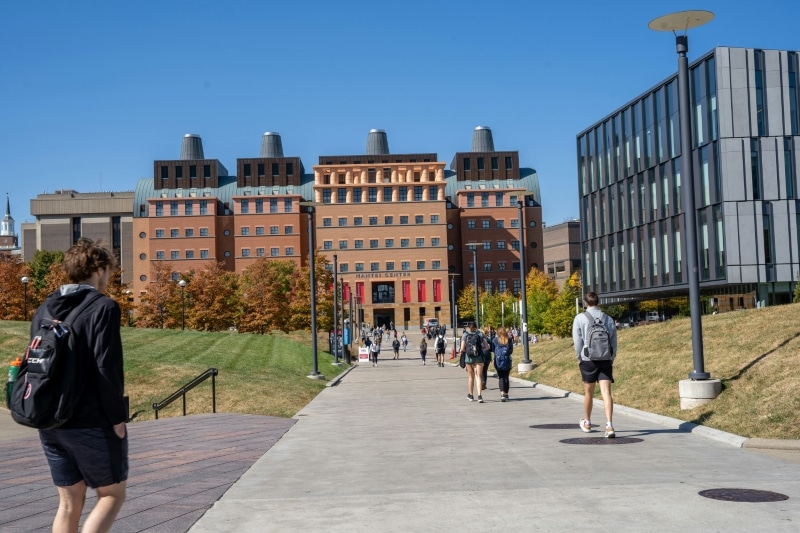
Hello! Many people dream of moving abroad to start a new life in a foreign land. But relocating isn’t just about dreams and inspiration; it’s a decision that requires a clear plan. Especially when your destination is “the United States of America”, the land of opportunity where many aspire to live. Whether it’s for education, work, or starting a new long-term life.
Before you pack your bags, I just want to let everybody know that “the cost of living here” isn’t like in the movies or series you’ve watched. One of the critical factors to consider is that the cost of living in America is quite high. It’s said to be one of the most expensive places in the world. So, if you’re planning to move there, you have to plan your finances carefully. Whether it’s housing costs, insurance, food, utilities, family expenses, travel costs, and many other living expenses that will follow.
In this article, I’m going to give you an overview of the essential expenses for living in the U.S. It’s detailed and easy to understand, so you can plan confidently and live the way you really want to. Ready? Let’s check out the costs!
This article will take approximately 35 minutes to read. Don't have the time right now? No worries. Email the ad-free version of the article to yourself and read it later!
Disclaimer: This article may include links to products or services offered by ExpatDen's partners, which give us commissions when you click on them. Although this may influence how they appear in the text, we only recommend solutions that we would use in your situation. Read more in our Advertising Disclosure.
Contents
Key takeaways
- The cost of living in the U.S. varies greatly depending on the city and state. New York and Los Angeles are considered the most expensive, while mid-sized cities like Austin or Chicago might be easier on the wallet.
- Rent is the biggest expense, with a one-bedroom apartment costing about US$1,600–2,800 per month.
- Utilities (electricity, water, gas, internet) together average around US$300–400 per month.
- Transportation costs vary by city. If you use public transport, it’s around US$125–150/month on average. But if you drive, expect to pay US$400–700/month for gas and insurance.
- Food costs: If you mostly cook at home, expect US$350–500/month. Eating out or frequenting fast food could push it up to US$700–1,200/month.
- Health insurance is essential, averaging US$539–621/month.
- If moving with family, education, daycare, and kids’ activities can add several thousand dollars a month.
- Average expenses:
- Budget US$1,500–2,000/month: Living modestly in less populated cities.
- Budget US$2,500–4,000/month: Basic cost of living in larger cities.
- Budget US$5,000+ per month: Comfortable daily living expenses in any city.
Housing Costs in the United States
For those considering moving to the United States, I want to first highlight the main expenses everyone will encounter, and that’s “accommodation”. Once you’re here, having a stable place to live is crucial if you’re planning a long-term stay. The key questions are “What kind of place will you live in?” and “How much will it cost?” I’ve roughly outlined these expenses to make it clearer.
Renting a Home
The first time I went to America several years ago, I rented a room with a friend in the suburbs of Texas. The room was just a small 30 square meter space with only two beds, air conditioning, and a bathroom. That was it. Back then, I paid about US$400 a month for the room, which was quite expensive compared to what you got (if it were in Thailand, with this budget, I could rent a nice condo in the city).
But if you’re in the city, rent prices go up significantly. On average, the cost to rent a house in America looks like this:
- 1-2 bedroom single-family homes Average rent nationwide is about US$1,400 – US$2,223 per month
- Single-family home with 3 bedrooms Average rent across the country is about US$2,200-3,100 per month
- Large single-family home with 4 or more bedrooms Average rent across the country is about US$2,500-4,200+ per month
However, the cost of living, including rent, varies greatly in each state as shown in the table below.
| City/State | 1–2 bedrooms | 3 bedrooms | 4+ bedrooms |
|---|---|---|---|
| Texas (Austin) | ~US$1,500 | ~US$2,400 | ~US$3,200 |
| New York City | ~US$2,800 | ~US$4,500 | ~US$6,000+ |
| Ohio (Columbus) | ~US$1,000 | ~US$1,800 | ~US$2,300 |
| Washington (Seattle) | ~US$2,000 | ~US$3,200 | ~US$4,500 |
Most homes in America are unfurnished, without furniture. *Except for short-term rental homes, which might come fully equipped. Appliances are usually included, such as gas/electric stove, refrigerator, microwave, dishwasher, air conditioner/heater, and washer/dryer (often within the house). Homes often have specific amenities like a garage, front yard, storage room, and even a BBQ area for parties.
Remember: When renting a house in America, don’t forget to account for the security deposit, which is usually equivalent to 2 months’ rent on average.
Apartment Rental Costs
For those looking to rent an apartment, whether you’re alone, a couple, or a family, the average rent for apartments in 2025 across the country is estimated at roughly US$1,600-1,800 per month depending on the number of rooms. They are divided as follows:
- Studio about US$1,684 per month
- 1 bedroom about US$1,628 per month
- 2 bedrooms about US$1,885 per month
- 3 bedrooms about US$2,290 per month
These figures are just estimates since rental rates vary greatly by state. For example, a 40 square meter room or a 1-bedroom apartment averages around this per month excluding utilities:
- Ohio: US$800 – 1,100 per month
- Texas: US$1,000 – US$1,300 per month
- Seattle: US$1,800 – US$2,500 per month
- New York: US$2,500 – US$3,500 per month
The prices mentioned for all 4 sizes are for unfurnished apartments (without furniture). Some places offer built-ins like wardrobes, shelves, kitchen counters. Appliances usually include a fridge, oven, dishwasher (almost 100% included), air conditioning/heater (depends on the city and state), and washer/dryer (some have in-unit, others shared by floor). Common facilities often feature a gym, swimming pool, shared laundry room, co-working space, BBQ area/lawn, and security systems (key cards, digital locks).
For those looking for a furnished apartment, expect higher rent compared to unfurnished ones. Prices typically increase by about 10-25% per month, depending on the city, location, room size, and the quality of the furniture provided.
House Prices
If you don’t want to rent a house, buying one might be a good option if you have enough money to do so. Actually, buying a house in America isn’t just for those who want to settle there long-term. It’s also a great investment opportunity. I’ve seen many people knowledgeable in this area buy houses when they move to America. Even if they only stay a few years, when they move out, they sell the house and make a huge profit. Bangkok’s governor is one of them. He bought a house for his child when they went to study in America, and after graduation, sold the house.
That being said, I’m not suggesting everyone should buy a house, because this option is only suitable for those with investment funds and knowledge.
The average price of a “second-hand” home nationwide (March 2025 data) is around US$403,700+, while a “new” home is about US$407,200+ (April 2025 data). These prices exclude interest. As of June 2025, the 30-year fixed mortgage rate sits at 6.84%, making the monthly payment around US$2,100 (assuming a 20% down payment). Don’t forget to add property taxes, insurance, and HOA fees on top of this.
Of course, home prices vary greatly from state to state, and location also affects the price.
While mortgage payments might seem higher than rent, the advantage of owning a home is that “you’re holding an asset” that could increase in value over time. Your family gets more private space, you can decorate and renovate as you please, and it’s perfect for those who want to keep pets.
Utilities
Even after factoring in rent or mortgage payments, that’s not the end of the story. Of course, you need to consider the recurring monthly expenses known as “utilities” including electricity, water, gas, internet, phone, or streaming service fees. It’s essential to be aware of these basic necessities beforehand. These costs are rough estimates and depend on usage.
Electricity, Water Supply, and Gas Costs On average, the total cost for all three is about US$266 per month. This amount can be more or less depending on the weather, house size, and number of people. On average, it breaks down into:
- Electricity costs around US$146 per month for a medium-sized house, covering lighting, appliances, and air conditioning. Especially in summer, electricity bills can soar to US$180-200 per month in some states like California or Texas.
- Gas for homes using gas for cooking or water heating costs approximately US$95 per month on average during winter.
- Water and Sewage averages around US$73 per month for a family of 3-4 people.
Of course, the prices vary by state since each state has different utility taxes and weather conditions.
I have a friend in Seattle who rents a room with their family of four and pays around US$150 a month for electricity. But another friend of mine in Texas pays about US$250 per month. This is because Texas is much hotter than Seattle, so my friend in Texas has to keep the air conditioner on almost all the time when at home.

Internet and Phone Costs
My friend in America pays about US$80 per month for home internet, which is what most people pay there for high-speed fiber or cable internet. Including modem rental and taxes, the cost may rise by another US$10-15.
As for mobile phones, unlimited data plans from major carriers like Verizon, AT&T, or T‑Mobile average around US$60-80 per number. If you’re in a family with multiple lines, you can opt for a family plan, which is slightly cheaper.
Cost of TV and Streaming Services
The cost of services like Netflix, Disney+, Hulu, Max in America is quite more expensive than in other countries. Each household spends about US$42 per month, and most people I know subscribe to at least 3-4 streaming apps.
Some of my friends still use traditional local cable TV services because it’s more convenient, but it is also more expensive, with total costs potentially reaching US$100-150 per month.
Travel Costs
Travel costs in America are another important factor that you need to plan carefully. However, everyone’s travel expenses can vary greatly depending on which state and area you live in, as travel costs aren’t the same across all cities. You also have the option of choosing your mode of transport. In big cities, public transportation like trains, buses, and metros are often used. But if you head to the suburbs or countryside, a car becomes necessary and much more convenient. Let’s see what the average travel costs are for both modes of transportation.
Public Transportation (Trains, Buses, Metro)
Many might not know that public transport in the US is often found in big cities, like New York, San Francisco, Washington D.C., Chicago, and Boston. In these cities, you don’t really need a car; trains and buses are much more convenient. On average, a subway/bus fare is around US$2.50-2.90 per trip (for example, MTA in New York). Alternatively, you can pay for unlimited travel at around US$125-150 per month
City examples:
- New York (MTA Subway/ Bus) Standard fare US$2.90 per trip (OMNY/ MetroCard). Monthly pass, 30-day (MetroCard/ OMNY) US$132 (capped daily fare US$34)
- Los Angeles (Metro Rail & Bus) US$1.75 per trip (including transfers within 2 hours). Monthly Metro pass US$100 per month
- Miami (Miami-Dade Transit) $2.25 per trip using an EASY Card, with a monthly pass available for $112.50 per month

Costs of private car, gasoline, and car insurance
Many of my friends in the U.S. primarily travel by private car because it’s such a large country. Driving across states for days is normal here. Plus, outside of major cities, private cars are much more convenient. The good thing is, cars in the U.S. are quite cheap, even cheaper than in Thailand, although wages in the U.S. are much higher than in Thailand.
Apart from providing convenience for travel, having a car is perfect for family outings, traveling with friends, or transporting goods. However, owning a car comes with costs such as fuel and car insurance. Let’s take a look.
Fuel Costs
The price of gasoline in America is considered relatively cheap compared to the average wage in the country. Gasoline is priced per “gallon” rather than per liter, with 1 gallon equaling about 3.785 liters. Based on the average prices in the U.S., here’s how it breaks down:
- Regular Gasoline: Average of US$3.22 per gallon
- Mid-Grade Gasoline: Average of US$3.69 per gallon
- Premium Gasoline: Average of US$4.05 per gallon
Since 1 gallon = 3.785 liters, the approximate price per liter is:
- Regular: US$0.85/liter
- Mid-Grade: US$0.98/liter
- Premium: US$1.07/liter
The monthly gas expense really depends on individual usage. Assume you’re driving a mid-sized car for 1,000 miles a month (about 1,600 km), with an average fuel efficiency of 25 miles per gallon. The car will need 40 gallons (about 151 liters) of fuel.
The monthly gas cost would be approximately:
- Regular: $129 (151 × 0.85)
- Mid-Grade: $148
- Premium: $162
Recently, many cities in America have started adopting electric cars, especially in big cities with ample charging stations, like Seattle. My friend living there mentioned that Tesla cars are everywhere because they’re extremely popular, which, of course, further lowers travel costs by about 2-3 times.
Car Insurance Costs
Auto insurance is also necessary for those who use cars in America. The average insurance cost across the US in 2025 is about US$2,683 per year, which averages out to US$220 per month. However, the cost can vary depending on the insurer and car model. Generally, it ranges from around US$1,900 to US$2,700 per year, or US$160 to US$225 per month.
Food Costs
In America, each meal comes with a cost, whether you eat at home, cook for yourself every day, shop at the supermarket, or grab convenience from fast food places. How much you pay really depends on your eating lifestyle. But I’ll give you a rough estimate of how much you’d spend with each option.
Cooking for Yourself
When moving to America, most people usually cook for themselves, especially if their income isn’t very high. Cooking at home can save you a lot of money because dining out there can be expensive if you do it often. Home-cooked meals are definitely more cost-effective.
When I’m in America, I love to visit big supermarkets like Costco or Walmart to stock up on essentials for the week, whether it’s fresh food, dry goods, or household items. Not only are they cheaper, but they also cut down on frequent shopping trips, making life more convenient and saving money.
Ingredients for cooking in America are relatively inexpensive compared to the average income there. Especially when comparing to dining out, which can be much more costly. If you can cook for yourself, it can save you a lot on your monthly expenses.
Example of average grocery prices:
- Chicken breast (boneless): US$4–5 per kilogram
- Eggs (1 dozen): US$2–3 per dozen
- Fresh milk (1 liter): US$1–1.3
- Beef (regular cuts, not ground): US$8–10 per kilogram
- Fresh vegetables like lettuce, broccoli, carrots: US$1.5–3 per head or bag (depending on type)
- Uncooked rice (white or jasmine, imported): US$2–4 per kilogram
These prices might vary slightly depending on the state you live in or the store you shop at. But overall, if you cook at home a few times a week, you can save a lot more money than eating out every meal.
From my survey, the monthly cost when cooking your own meals generally comes out like this.
- For adults aged 19-50, a family of about 4 might buy groceries at an average of $350 per person per month (around $11.67 per day), or collectively for multiple people, it could be roughly 1,200+ dollars a month.
- But for singles, it tends to be more expensive. Living alone allows for indulging at an average of $400-500 per month (about $16.80 per day), or even above that, expecting expenses to be in the range of $504 per month (around $15 a day).
Dining Out and Fast Food Costs
For those who enjoy eating out or love fast food like McDonald’s, Wendy’s (I personally love their sandwiches, they are really delicious), Taco Bell, or Chinese food at general food courts, the price is around US$10–US$15 per meal, which isn’t too expensive considering the convenience and speed.
But fast food places also have promotion menus, which cost just about US$4-US$5 per meal. When I first moved to America, I ate them all the time!
But if you’re dining at a general restaurant, especially those with table service, you should budget around US$20–US$25 per meal. And don’t forget, in America, it’s a “tipping society.” When dining at such places, plan to leave a tip of another 15–20% of the bill. If you don’t tip, especially in places with waitstaff, you might be looked at unfavorably or get some strange looks from the servers.
On a monthly average, here’s what you might spend on food:
- If eating by category, fast food 2 meals a day = US$700/month
- Dining at regular restaurants for all 3 meals = US$1,740 per month
- Or a mix of fast food 1 meal + restaurant 1 meal + cooking for yourself 1 meal = US$1,250 per month
If you want cheaper food costs, try cutting out the non-essential parts or cooking at home. Of course, some may spend more or less depending on how often they dine out and where they eat.
Entertainment and Leisure Costs
Life in America isn’t just about working 9 to 5, right? You’ve got to have some time after work or on days off to catch a movie, hit the gym, hang out with friends, or explore new places. Entertainment expenses are a sure thing. Let’s dive into the popular activities and what they might cost.
- Going to the movies Average ticket price nationwide is US$16.08 per screening. In New York or San Francisco, it might go up to US$23+, while in states like Wyoming, it could be as low as US$9.08. If you add popcorn and drinks, expect about US$8-15 per set.
- Fitness/Gym Commercial gym memberships cost US$30-70 per month. Budget gyms start at US$10-25 per month, and premium gyms cost US$150-300+ per month.
- Concerts & Live Music Mid-range concert tickets (Top tours) cost about US$144 per ticket, with prices higher for top artist tours, averaging US$206.47. Music festival tickets range from US$200-600 (excluding food, drinks, accommodation, and travel expenses).
- Bars & Craft Beer Prices are around US$7-14 per glass.
Family Expenses
Moving to live in the USA with your whole family can definitely mean high costs, starting from renting a big enough house for everyone. If you have kids, you’ll need to consider childcare, daycare, and education expenses. Let’s take a look at these costs.
Education Costs (Private Schools and Universities)
Let’s talk about private schools first. Whether it’s elementary or high school, tuition fees differ. The national average is US$14,903 per year (data for 2025), with elementary level averaging US$13,931 per year and high school level averaging US$17,811 per year.

For universities, they are categorized by state. For in-state public universities, the average cost is about US$11,610 per year for a 4-year university. For out-of-state public universities, the average is US$30,780 per year. And for private nonprofit universities, the average tuition is between US$38,421 and US$42,162 per year.
Examples of leading university tuition fees (per year)
- Harvard University: US$59,000
- Stanford University: US$62,000
- MIT (Massachusetts Institute of Technology): US$61,000
- Yale University: US$64,000
Childcare or Daycare Costs
Another crucial factor for those with young kids is the cost of childcare or daycare. On average, childcare centers cost about US$340-345 per week, roughly US$1,480 – US$1,500 per month, and about US$13,128 per year.
Or if anyone wants to hire a nanny, the average cost is about 3,280 per month. But if you want to save some money…
Tip: I know some families who hire nannies straight from Thailand and help them with visas and health insurance. This is a great way to get a nanny that fits your needs at an affordable rate.
Healthcare and Health Insurance Costs
Healthcare in the US is notoriously expensive. I’ve seen many videos showing healthcare costs here, and they are indeed high. A single treatment can easily go into the hundreds of thousands or more, meaning health insurance is absolutely essential here.
Doctor Visit Fees
Let me break it down like this: there’s a difference in cost for those with and without insurance.
- Without insurance General doctor visits are 100-300 US$ per visit. If seeing a specialist (like a specialist doctor), it costs 150-600+ US$ per visit, and general urgent care clinic visits are 150-250 US$ per visit.
- With insurance Copay: 10-50 US$ per visit depending on the plan (PPO/HMO) and a monthly premium of 539-621 US$. The most popular plan is Silver-tier ACA.
For those just starting to learn about the health insurance system in the USA, it might be confusing with plan names like HMO, PPO, or Silver-tier. Here’s a simple breakdown for you.
HMO Plan (Health Maintenance Organization):
This is a more affordable plan suitable for those who want to manage their expenses and can plan ahead. You need to choose a Primary Care Physician and all treatments require a referral from your primary care doctor. The limitation is you must use in-network services only. If you go outside the network, you’ll have to pay the full amount yourself, 100%.
PPO Plan (Preferred Provider Organization):
This plan offers more flexibility. You can choose your own doctor or hospital without needing a referral and can even see doctors outside the network, though it will cost more. It’s ideal for those who want more options and fewer restrictions.
Levels of ACA (Affordable Care Act) insurance plans:
In the US health insurance market, there are plans divided into levels like bronze to gold to choose based on budget and needs.
- Bronze: The lowest premiums, but you have to pay a lot out-of-pocket before the insurance kicks in.
- Silver: A mid-level plan that is the most popular on the market, as it gets the most discounts (through government subsidy). The premiums aren’t too high, but you still need to copay or pay some deductible.
- Gold: Higher premiums, but the insurance covers more.
- Platinum: The highest premiums but the most coverage, ideal for those with frequent healthcare expenses.
* ACA (Affordable Care Act) is a healthcare law in the US designed to allow Americans (and eligible residents) to access affordable health insurance.
Medication Costs
Medication costs can be tricky to pin down since there are both specific and general drugs that differ in price. For over-the-counter meds, like pain relievers or fever reducers, expect to pay around US$6.26 per pack, while anti-inflammatory drugs range between US$4.11 – US$10.83 per pack. Want cheaper deals? Use coupons (GoodRx, SingleCare) to save 5-10% off.
Private Health Insurance
In the US, many people opt for private health insurance through the marketplace under the ACA (Affordable Care Act). A popular choice is the Silver-tier plan, which balances premium costs and benefits nicely.
Typically, the insurance premium
- For a Silver-tier plan is around US$621 per month, or about US$7,452 per year for the average policyholder.
- If you’re around 40 years old, the average premium is about US$539 per month, or approximately US$6,468 per year.
However, these premiums vary by state.
For those with employer-sponsored health insurance plans, the premiums are usually lower than buying a plan through the ACA marketplace. Employers generally contribute to the premiums, resulting in employees paying about US$120 per month.
Tip: But if you compare, in my opinion, if you need to buy health insurance yourself, it’s worth checking out expat-specific health insurance. These often have similar prices to ACA but include international coverage. A popular option I see a lot of people using is Cigna Healthcare.
Visa Fees and Residency Situation
Another cost that people tend to forget is the “visa” fee. Normally, it costs about US$185, whether it’s a short-term visa like a tourist visa (such as B-1/B-2) or a long-term student or work visa (such as H-1B, F-1, L-1). Plus, there are hidden costs like document fees as well.
But if you’re looking at investment visas, the fees skyrocket, possibly reaching about US$2,000 – 5,000 or more. To be honest, it’s quite normal for this type of visa to have especially high fees, no matter which country it’s for.
As for a Green Card, whether through family, employment, or investment the average cost is around US$3,000.
Average Costs in Different Cities in the United States
Alright, let me break down the average expenses in various cities in the United States for you. These will be popular major cities where people often like to move to. It gives you an overall rough estimate of what the total expenses might be. The numbers provided are just a basic guide to cover everyday living costs, including cooking at home sometimes.
New York
New York City is considered the most expensive city in America in terms of cost of living, and nearly the most expensive in the world. Overall, it has costs that are about 74% higher than the national average, especially housing, which is more expensive by 218% compared to the average.
Example of monthly expenses in New York
- The rent for a one-bedroom apartment in the city center is about US$4,809 per month.
- Food (cooking at home + eating out occasionally): US$500–800
- Utilities (electricity, water, gas, internet): US$200–300
- Transportation (MetroCard or monthly travel pass): US$130
- Private health insurance (if not covered by an employer): US$500–600
- Miscellaneous expenses (clothing, medicine, gym, phone bills, etc.): US$300–400
Overall, the monthly expenses (excluding rent) for a single person in New York are about US$1,600–2,200 per month
and if you include rent, it could be as high as US$6,000–7,000 per month.
So, unless you have a fairly high income or free accommodation / share a house with others, New York is considered a “tough city” for those looking to save money.

Los Angeles, CA
Los Angeles is another city with a very high cost of living. Both rent and food are more expensive than in other places, but overall, it’s still cheaper than New York.
Sample monthly expenses in Los Angeles
- Rent for a 1-bedroom apartment in the city center: about US$2,779 per month
- Food (cooking at home + eating out occasionally): US$500–800
- Utilities (electricity, water, gas, internet): US$200–300
- Transportation (monthly pass or car expenses): US$130
- Private health insurance (if not covered by an employer): US$500–600
- Miscellaneous expenses (clothing, medicine, gym, phone bills, etc.): US$300–400
In total, the monthly expenses (excluding rent) for a single person in Los Angeles are about US$1,600–2,200 per month.
But with rent included, it could be around US$4,400–5,000 per month.
Austin (Austin, TX)
Austin is a major city in Texas that I find to be fairly affordable and convenient to live in, without being overly expensive.
Example monthly expenses in Austin (for one person, excluding rent)
- 1-bedroom apartment rent: US$1,612–1,669 per month
- Food (home-cooked + eating out occasionally): US$400–600
- Utilities (electricity, water, gas, internet): US$150–250
- Transportation (gas or public transportation): US$100–150
- Private health insurance (if not covered by employer): US$400–500
- Miscellaneous expenses (clothing, medication, gym, phone bills, etc.): US$200–300
Overall, the monthly expenses (excluding rent) for a single person in Austin are about US$1,100–1,800 per month.
But if you include rent, you should budget for around US$2,700–3,500 per month.
If you want to live comfortably, have savings, and not have to cut back too much, many suggest that research indicates an appropriate budget for living in Austin should be around US$4,500 per month.
Seattle, WA
Seattle is another city that I find quite interesting. Of course, the cost of living might be slightly higher than other cities because it’s a big city, but overall quality of life is pretty good. Plus, there are plenty of job opportunities, especially in the tech industry.
Example of monthly expenses in Seattle
- Rent for a 1-bedroom apartment in the city center: around US$2,365 per month
- Food (cooking at home + eating out occasionally): US$500–800
- Utilities (electricity, water, gas, internet): US$200–300
- Transportation (monthly pass or fuel costs): US$120–150
- Private health insurance (if not covered by an employer): US$500–600
- Miscellaneous expenses (clothing, medicine, gym, phone bills, etc.): US$300–400
In total, the monthly expenses (excluding rent) for a single person in Seattle are about US$1,700–2,300 per month.
When you include rent, the monthly budget comes to approximately US$4,000–4,600.
Even though the cost of living is high, Seattle is a city with a good quality of life, high average income, and a fairly comprehensive public transport system compared to other cities in the U.S.
Cincinnati, OH
Personally, I feel quite attached to Ohio because it’s one of the first states I ever stayed in, even if it was just crashing at a friend’s house. Plus, a close friend of mine graduated from a university there. To me, Cincinnati is a great example of an American city. It’s still a big city with all the necessary amenities, but it’s not as hectic as major cities like New York. Life is generally easygoing, and the cost of living isn’t too high, making it perfect for anyone looking for quality living on a reasonable budget.
Sample monthly expenses in Cincinnati
- Rent for a 1-bedroom apartment downtown: around US$1,200–1,350 per month
- Food (home-cooked + eating out occasionally): US$400–600
- Utilities (electricity, water, gas, internet): US$150–250
- Transportation (private car or public transport): US$100–130
- Private health insurance (if not covered by employer): US$400–500
- Miscellaneous expenses (clothing, medication, gym, phone bills, etc.): US$200–300
In total, monthly expenses (excluding rent) for a single person in Cincinnati can range from US$1,200–1,800 per month.
Including rent, the budget would be around US$2,400–3,200 per month.
Overall Expense Summary
Let’s wrap up with an overall expense summary. I’ll divide it based on lifestyle so you can see what each budget might accommodate.
US$2,000 Monthly Budget
If you’re planning to live in America with this kind of monthly budget, you can actually manage, but it might be quite “challenging”. Here’s what living conditions would be like:
- You’ll need to live in a secondary city where the cost of living isn’t too high, like Ohio or some cities in Texas, rather than places like New York or Los Angeles.
- Share accommodations with a roommate or rent a small room.
- Cook your own meals primarily, and eat out less often.
- Travel by public transportation because having a car involves extra expenses like gas, insurance, and parking fees.
Honestly, I think it’s better to increase the budget a bit more so you can live comfortably. This way, you won’t have to stress too much about expenses, and you’ll have some left over to travel or socialize. Plus, you’ll have some emergency savings as well.
Budget: US$ 3,000 per month
If you have a budget of around US$ 3,000 per month to live in America, I think you can start to “live comfortably.” However, you still need to plan carefully. Here’s roughly what your living situation would look like:
- You’d need to choose a city with a moderate cost of living, like Cincinnati or Austin.
- You may still need to share an apartment, or if you live alone, you might have to rent a room that’s not in the city center.
- Primarily cook at home, but can afford to eat out 1-2 times a week.
- Still need to rely mainly on public transportation.
- If you have a personal car, it might need to be a used one.
Truth be told, this budget allows for a decent life in the US in cities or states where the cost of living isn’t too high. However, it’s not entirely comfortable, and you’ll need to watch your spending a bit. If you can increase your budget slightly to around US$3,500–4,000 a month, it would significantly enhance your quality of life.
Budget of US$4,000 per month
If someone has a budget of about US$4,000 per month to live in America, I think life starts to get “comfortable” enough. There’s less stress about daily expenses, and you have some room for a better quality of life. Here’s roughly what the overall living situation would be like:
- You can choose to live in either mid-sized cities or some larger ones like Seattle, Austin, or even Los Angeles if you opt for outer zones or shared accommodations.
- It’s possible to rent a room on your own without having to share with roommates.
- There’s a budget for cooking at home mainly, but you can dine out several times a week.
- You can use a personal car without impacting the overall budget.
- You can afford mid-to-good quality health insurance.
- Budget for other activities like holidays, personal shopping, and fitness
- Save some emergency funds each month
Overall, a budget of US$4,000 per month allows for a comfortable life in America, especially if you’re not in a city with a high cost of living. I’d say it’s pretty comfortable.
Monthly Budget of US$5,000+
If you have a monthly budget of US$5,000 or more to live in America, you’re at a level where you’re genuinely living comfortably—no need to constantly worry about daily expenses, and you have quite a bit of freedom in how you choose to live. Here’s what that lifestyle might look like:
- You can live in nearly any city in the U.S., including expensive places like New York, San Francisco, or Seattle, without needing to share a room with anyone.
- Rent a quality condo or apartment in a convenient location.
- Easily dine out; going to nice restaurants several times a week is not a problem.
- Fully enjoy having your own car.
- Afford good health insurance.
Simply put, with a budget like this (around US$5,000 per month), you can live comfortably in the U.S. Living in a big city like Los Angeles or even New York is manageable without much strain. Dining out, traveling, using a personal car, or renting a nice place is all within reach.
But honestly speaking, it’s not exactly “really comfortable” yet, especially if you’re in a city with a very high cost of living like New York or San Francisco. If you want to live without much worry, eat whatever you like, stay in a condo downtown, have a car, savings, and travel frequently without concern, you might need to look at a budget level of US$6,000 or more per month to make it work.






